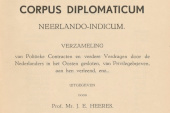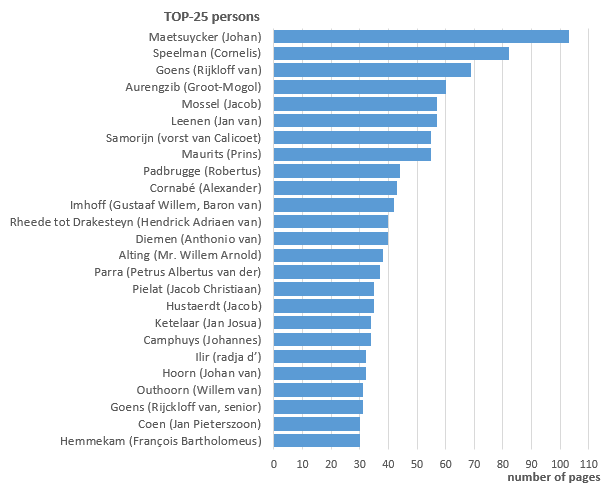Corpus Diplomaticum 1595-1799

The Corpus Diplomaticum Neerlando-Indicum comprises six volumes, and was published between 1907 and 1955 by Mr J.E. Heeres and Dr F.W. Stapel at the Koninklijk Instituut voor Taal-, Land- en Volkenkunde (KITLV) as a ‘Bijdrage tot de Taal-, Land- en Volkenkunde van Nederlandsch-Indië’. These volumes contain a collection of political contracts and treaties concluded by the Dutch in Asia and permits granted to them.

The document descriptions and transcriptions to be found in these volumes were initially based on five so-called Contract-books, which are at present held in the National Archive at The Hague. These Contract-books originally came from the VOC chambers of Amsterdam (four books) and of Middelburg (one book). The contracts cover the period of the Pre-companies and of the VOC, that is, from 1596 to 1799. During the nineteenth century there was already a great need for and interest in the contracts, because they could shed light on the relations between local rulers and the government in Batavia. However, because it turned out to be impossible to provide a complete picture, earlier initiatives were not continued. Only at the beginning of the twentieth century was a fresh start made with transcribing the contracts from the above Contract-books and with supplementing them from other sources.
The Contract-books contain copies of contracts which already in the 17th century were sent from the castle of Batavia to the Republic in the Netherlands. The original contracts were sometimes also sent separately, and can be found in the archive series ‘Overgekomen brieven en papieren uit Indië’ [Letters and papers received from the Indies], and also in the ‘Dagh-Register gehouden int Casteel Batavia’ [Daily Journals kept in Batavia Castle]. The original Contract-books overlap in chronology and are incomplete. This is also apparent from a study of the other archive series mentioned. When supplemented with contracts from these series (in particular for the 18th century), the whole provides a fairly complete picture.
Specifically for the first volume of the Corpus Diplomaticum, Heeres studied the archives in The Hague, and not the VOC archives left behind in the national archive in the Indies. At the time when the first volume was being compiled, a list of contracts was sent from Batavia to the Netherlands, but apparently it was not considered worth the time and effort to include the few relevant contracts from it. But from the second volume Heeres did devote more attention to the documents still to be found in the national archive in Batavia, but it is not completely clear in what way and to what extent. In the present inventory of the VOC archive in Indonesia (Brill 2007) we find the section ‘Verdragen en Contracten’ [Treaties and Contracts] (inv. nrs. 3595-3620), which could be checked once more to find out whether additions to the Corpus Diplomaticum are still possible. This relates to extracts and copies of treaties and contracts with various rulers, but sometimes also originals with the Dutch translations alongside them.
The 17th century shows a sharp rise in the number of contracts per year in the Corpus Diplomaticum, but at the beginning of the 18th century there is a remarkable drop. On the one hand at that time there were more regions which had accepted unlimited sovereignty, and so no new contracts were needed with local authorities, and on the other hand the area in which the Company exercised its influence had become so wide that further expansion was no longer profitable. The geopolitical and commercial sphere had reached its maximum extent, from the Cape of Good Hope as far as Japan. The contracts from the 18th century were primarily intended to consolidate and maintain existing contacts, and not to formalize new ones. The activities of the Company in parts of Persia even went into a steep decline as a result of wars, trading disputes and changes in the local regime.
Each of the contracts from the six volumes of the Corpus Diplomaticum is described briefly and placed in a searchable database on this website. The contracts are linked to the scans of pages from the Corpus Diplomaticum, where one can read the complete text. Each volume has a separate index of persons and placenames. In combination and in separate databases these have been made completely searchable and likewise linked with the scans.


The following persons have made this digital publication possible through their effort and expertise:
- Fanada Sholihah, History Department, Faculty of Humanities, Semarang
- Marco Roling, The Corts Foundation, Information engineer
- Jelle Gerbrandy, Software engineer
Continue to the contracts on the next page: Browse Contracts
REFERENCES
Corpus Diplomaticum Volume 1 (1596 - 1650), Mr. J. E. Heeres, KITLV 57, 1907
Corpus Diplomaticum Volume 2 (1650 - 1675), Mr. J. E. Heeres, KITLV 87, 1931
Corpus Diplomaticum Volume 3 (1676 - 1691), Prof. Mr. J. E. Heeres, KITLV 91, 1934
Corpus Diplomaticum Volume 4 (1691 - 1725), Dr. F. W. Stapel, KITLV 93, 1935
Corpus Diplomaticum Volume 5 (1726 - 1752), Dr. F. W. Stapel, KITLV 96, 1938
Corpus Diplomaticum Volume 6 (1753 - 1799), Dr. F. W. Stapel, KITLV, 1955
RESEARCH DATA OF THE CORPUS DIPLOMATICUM
You may download the data set here for your own research and analysis.
There are three separate files for contracts, persons and places.
Dataset on contracts v20190226:![]()





